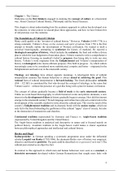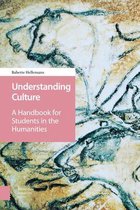Chapter 1: The Classics
Elaborates on the first thinkers engaged in studying the concept of culture in a theoretical
way. About Classical Cultural History, Philosophy and the Social Sciences.
This chapter is about understanding how the academic approach to culture has developed over
the centuries, in what context we should place these approaches, and how we have broken free
of old premises over the centuries.
The Foundations of Cultural Criticism
Many could qualify as the “inventor of cultural history.” However, Voltaire (1694-1778) is a
strong contender. Voltaire’s Essay on the customs and spirit of nations from 1756 is the first
attempt to broadly outline the development of Western civilization. He wanted to draft a
universal historiography, attempting to synthesize the history of mankind. He rejected a
theological conception of history, which includes the eschaton; the final end within a divine
plan in which the Last Judgement of man takes place. Voltaire wanted to write a comprehensive
cultural history focusing on mankind’s belief in progress, thus being able to write our own
history. Voltaire’s work originates from the Enlightenment and Voltaire’s interpretation of
history is teleological (telos means ultimate purpose). This faith in progress – by which culture
increasingly came to be considered more sophisticated, complex and better – originated in the
Enlightenment and took root in the nineteenth century.
Theology and teleology have almost opposite meanings. A teleological form of cultural
interpretation assumes that human behaviour is always aimed at achieving the good. This
rational form of cultural interpretation is forward-looking. The Greek philosopher Aristotle
(384 – 322 BC) is considered the first who devised the concept of teleology, in the sense that
Voltaire used it – without the presence of a god-like being with a plan for human civilization.
The concept of culture gradually became a field of study in the early nineteenth century.
Unlike an event-based historiography in which historical events and politics dominate, a new
interest in the development of ideas in history gradually began to emerge. How did this interest
emerge in the nineteenth century? French language and culture have played a central role in the
development of the scientific method to write about the cultural past. This was the result of the
country’s Enlightenment tradition and its dramatic break with the ancien regime, which not
only led to the literal beheading (by guillotine) of the cultural “upper” class of society, but also
to the destruction of monasteries and churches.
Continental tradition (represented by Germany and France) vs. Anglo-Saxon tradition
(represented by United Kingdom and the United States)
The Anglo-Saxon tradition is analytical and descriptive in nature and is focused mainly on
political history. Academic tradition in the Anglo-Saxon world makes a clearer separation
between philosophical approaches and intellectual and cultural history.
Herder and Hegel
Kulturgestichte: in German speaking a systematic programme arose under the influential
scholar Leopold von Ranke (1795-1886), the dominant Berlin view of history was empirical,
objective and therefore positivist. The past could be described wie es gewesen (“as it was”) The
cultural past existed as an objective fact.
In contrast to this approach in which man and human behaviour were seen as a constant, a
historicist movement developed within German Romanticism that sought more links with
1
,philosophy. This movement focused on the diversity of cultures and identities. Johann
Gottfried von Herder (1744-1803) wrote about the history of civilization.
Herder showed that knowledge of an idea in culture was not an absolute given but a
philosophical and historical question that was preceded by interpretation and methodology.
This is why every civilization, every period, and every culture should be studied within their
own parameters, and not by historians looking through their “moral glasses”. And one could
certainly not assume that access to the past was self-evident. This cultural interpretation is
called historicism; it marked a definite break with the teleological interpretation of the
development of civilizations. From this moment on, culture came to be seen as a subject of
study within the field of history.
While Enlightenment thinkers such as Voltaire and David Hume assumed that man was
essentially unchanging in time and space with history teaching us nothing new, Herder argued
the opposite.
An important concept that Herder introduced to describe the panoramic nature of culture is the
word Zeitgeist. Herder argued that man is actually unimaginably variable when dealing with
concepts, beliefs, feelings or interpretation. The theory of human and cultural variability had a
huge impact on hermeneutics (the study of how to interpret texts).
Georg Willem Hegel (1770-1831) distinguished between three types of “cultural history”: the
original historiography (eyewitnesses and chronicles), reflective historiography (scientific)
and philosophical history (teleology). Hegel’s interpretation of culture was very much focused
on the humanistic ideal of “the new man” born in the Renaissance. Hegel has had an enormous
impact on the way we look at culture today. Almost everything in (cultural) philosophy can be
traced back to Hegel. Nonetheless, Hegel’s view did need to be refined somewhat, not only
because Hegel assumed that man will always improve morally as time progresses and because
he espoused almost aggressively anti-religious views, but also because he took the elite as a
starting point for “culture”.
The Culture of the Renaissance
While Leopold von Ranke (1795-1886), saw the state as a centre of political stability, the
Swiss Jacob Burckhardt (1818-1897) regarded political power as malicious. Burckhardt, like
Herder, had an aversion to systems. Burckhardt intended to show that an objective and
empiricist view of a culture and its past can in fact only be subjective and that the (art) historian
in effect operates as a mediator between the past and the present. Burckhardt was one of the
first who built around a theory. The huge amount of documentation that he used can only be
processed when there is a theory behind it that helps in guiding, directing and selecting. This
method consisted of Burckhardt’s assumption that elements should be selected from all
manifestations from a culture. Architecture, sculpture and philosophy are all starting points that
enabled Burckhardt to describe to what extent these elements were an expression of the
Zeitgeist. This method reveals an exegetical disposition that was mainly about identifying and
explaining links and connections. This gradually put the cultural specialist in a quandary, for
creating the kind of coherence that Burckhardt was striving for was not easy. It is also therefore,
that the cultural scientist, attempts to establish logical connections within an entire universe of
meanings. This emphasis on broadening the definition of culture is also Marxism’s claim.
2
, The Warburg Institute
One of Burckhardt’s followers was Aby Warburg (1866-1929). Burckhardt’s interpretation of
culture primarily influenced Warburg. By founding his own institute in London, he gave shape
to his ideal. The foundation offered the public the chance to learn about culture through
interaction with all kinds of human cultural artefacts: books, coins, paintings, textile work and
so on. The establishment of a cultural institute would provide an opportunity for people to study
the symbolic forms of culture such as those seen in ethnology, religious history, language,
philology and astronomy. The synchronous nature of culture, with a focus on parallel
developments, thus became a fundamental part of Warburg’s work.
Iconology: the study of visual imagination and its symbolism, particularly its social and
political significance.
The Warburg method not only shows a deeper psychological understanding of culture, it also
aims to demonstrate how dangerous it can be to only want to understand Western culture from
one type of rationality that is considered superior. Warburg was concerned about such a superior
attitude, which he feared could lead to superstition, anti-Semitism or political radicalisation.
Research in the spirit of Warburg aims to show the origin of social meanings, images, symbols,
and beliefs oriented toward the “Second Enlightenment” that Warburg envisaged with his
institute.
Dilthey’s Hermeneutics
In addition to examining the connections between styles in art, thought patterns, and historical
events, research on culture in the 1920s increasingly began to incorporate ideas from the new
discipline of psychology. This was the result of Freud’s theory on the subconscious. Hegel’s
Geist or Herder’s and Burckhardt’s Zeitgeist already implied the existence of a kind of “spirit”
that held together the cohesion of a culture.
Willem Dilthey (1833-1911) was standing at the crossroads of different approaches that would
later grow into different academic disciplines such as history, philosophy, psychology and
sociology. Dilthey wanted to develop a method for the school called Geistesgestichte in
Germany, literally translated as intellectual history. The natural sciences had developed a strong
empirical methodology by the end of the nineteenth century and Dilthey thought it was
necessary for the humanities to formulate a counterpart that was at least as solid.
Dilthey concerned himself with hermeneutics; which stands for a theory in which all human
objectifications are interpreted. This includes not only the spoken or written word, but also
visual and artistic expressions, gestures, observations and actions. Because Dilthey’s work was
translated into English at a much later date, Dilthey’s influence had only slowly gained ground.
It was none other than sociologist Max Weber (1864-1920) who introduced Dilthey’s ideas to
the international community. The hermeneutical position held by Weber comes directly from
Dilthey.
Jürgen Habermas (1929) called the invisible factors, those factors that historical actors are
unaware of, “unconscious motivation”. Habermas argued that hermeneutics could be reached
through the principles of Freud’s psychoanalysis. In Freud’s psychoanalytic theory, the
subconscious is key: much of our conduct in adulthood stems from supressed feelings from our
childhood. Central to Habermas’ theory, which combines Freud’s psychoanalysis and Dilthey’s
hermeneutics, is the role that communication plays in what he calls the “public sphere”. In his
work from 1962, Habermas described how eighteenth-century salons and coffee houses created
3






